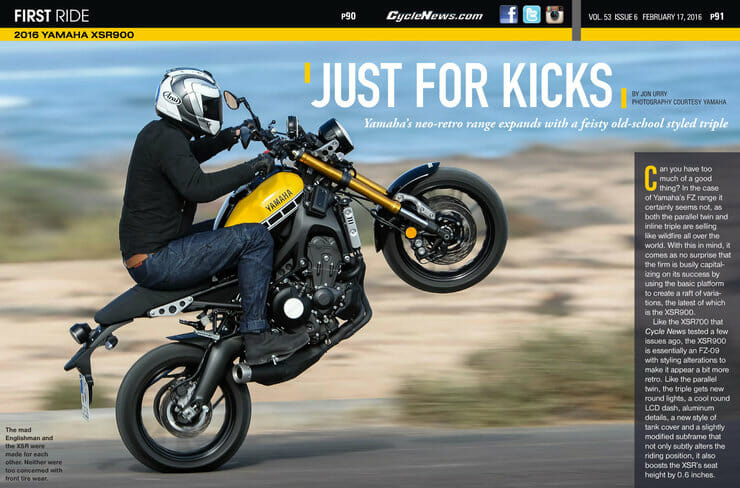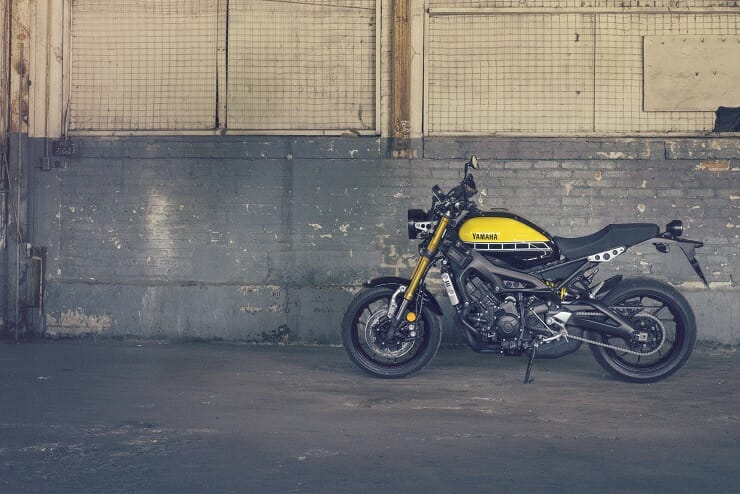| February 20, 2016
 The mad Englishman and the XSR were made for each other. Neither were too concerned with front-tire wear.
The mad Englishman and the XSR were made for each other. Neither were too concerned with front-tire wear.
– By Jon Urry Photography Courtesy Yamaha
Can you have too much of a good thing? In the case of Yamaha’s FZ range it certainly seems not, as both the parallel-twin and inline-triple are selling like wildfire all over the world. With this in mind, it comes as no surprise that the firm is busily capitalizing on its success by using the basic platform to create a raft of variations, the latest of which is the XSR900.

You can read the original magazine story by clicking HERE.
Like the XSR700 that Cycle News tested a few issues ago, the XSR900 is essentially an FZ-09 with styling alterations to make it appear a bit more retro. Like the parallel twin, the triple gets new round lights, a cool round LCD dash, aluminum details, a new style of tank cover and a slightly modified subframe that not only subtly alters the riding position, it also boosts the XSR’s seat height by 0.6 inches.
 The same front and rear lights as the XSR700 keep the family lineage.
The same front and rear lights as the XSR700 keep the family lineage.
One of the criticisms that has been leveled at the FZ is the fact its supermoto-style riding position and longer travel suspension than most nakeds gives it a tendency to rock back and forth on its suspension when pushed hard. By altering the damping rates and moving the rider back two inches in the saddle thanks to the new seat and tank, this sensation has been removed from the XSR and you can now corner with far more confidence. It feels much more like a conventional sports naked when it comes to its handling and this new security allows its light 430-pound weight and strong triple engine to be fully exploited.
 How can you not dig the “King Kenny” 60th Anniversary paint?
How can you not dig the “King Kenny” 60th Anniversary paint?
Although the majority of the triple has remained unchanged bar a bit of styling (the exhaust is matte black and the end can round while the engine cases have aluminum details) it has received a few tweaks that, like the chassis, make a noticeable difference to its character. Three new fuel maps (STD, A and B) go a long way to sorting out the slightly snatchy throttle response of the FZ, although as usual for a Yamaha, A mode is a bit brutal and generally best avoided. It’s not bad, it’s just on a bike that is as much fun to ride as the XSR it dampens the fun factor of the triple engine slightly. And it is a brilliant engine.
 The speed block colors look absolutely bitching.
The speed block colors look absolutely bitching.
As well as sounding absolutely superb when it is being fed revs, the XSR’s power delivery is bang on for road riding. Where an inline-four can be left feeling a little breathless in the lower rev range, the XSR drives out of bends with a lovely flat torque curve before delivering a cheeky little rush at the top. This means you aren’t left continually dancing on the gear shift and instead you can focus on getting the best out of the chassis and enjoying the ride. Something the designers at Yamaha obviously expected.
Unlike the XSR700, which has retro-style Pirelli Phantom tires, the XSR900 comes with Bridgestone S20R rubber. There is nothing wrong with the Pirellis, but a Yamaha man told me as they expect the bigger bike to be ridden harder, they chose grip over fashion. Good on them I say as the XSR900 is a fine-looking bike without the need to rely on trendy tires.
 For those that like a more understated ride, there’s also the matte grey color scheme.
For those that like a more understated ride, there’s also the matte grey color scheme.
In the “King Kenny” 60th Anniversary paint, the XSR900 looks amazing while the brushed aluminum also looks very stylish. Some riders preferred the yellow, personally I thought the aluminum showed the bike off the best, but either way the XSR900 is a hit with me.
SPECIFICATIONS: 2016 Yamaha XSR900
Engine: Three-cylinder, four-stroke, DOHC, four-valves per cylinder
Displacement: 847cc
Bore x stroke: 78.0 x 59.1mm
Horsepower: 113hp @ 10,000 rpm (claimed)
Torque: 64.5lb-ft @ 8500 rpm (claimed)
Compression ratio: 11.5:1
Transmission: Six-speed
Front suspension: 41mm inverted fork, adjustable rebound and spring preload
Rear suspension: Single shock absorber, adjustable rebound and spring preload
Front brake: Twin 298mm discs, four-piston radial calipers, ABS
Rear brake: Single 245mm disc, two-piston caliper, ABS
Front tire: 120/70 ZR17
Rear tire: 180/55 ZR17
Rake: 25°
Trail: 4.06 in.
Wheelbase: 56.69 in.
Seat height: 32.1 in.
Overall height: 44.9 in.
Overall width: 32.1 in.
Overall length: 81.7 in.
Fuel capacity: 3.7 gal.
Weight: 430 lbs (wet, claimed).
Colors: 60th Anniversary, matte grey
MSRP: N/A
You can read the original magazine story by clicking HERE.
For more Cycle News Standard motorcycle reviews, click HERE.
For more Yamaha motorcycle reviews, click HERE.